Elongated Skulls in utero: A Farewell to the Artificial
Cranial Deformation Paradigm?
Elongated skulls are usually explained in terms of head-binding or artificial cranial deformation. This paradigm emerged in the first half of the 19th century as a way of explaining unusual skulls discovered in Europe and South America, in places such as Crimea and Peru respectively. The main idea behind the head-binding paradigm is that ALL elongated skulls are a result of intentional modification of the form of the skull by applying external pressure. In other words, ALL elongated skulls are merely deformed ‘normal’ skulls similar to those of modern humans.
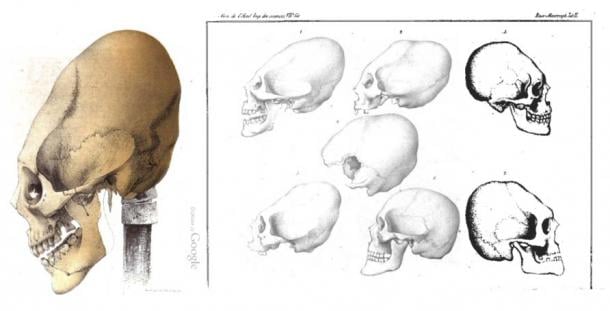
Elongated Skull from Crimea and other parts
of the worlds, Baer 1860
Rivero and Tschudi in Peruvian Antiquities (1851 Spanish, 1853 English) argue that the protagonists of the artificial cranial deformation hypothesis are mistaken, since they had only considered the skulls of adults. In other words, the hypothesis fails to take into account the skulls of infants and, most importantly, foetuses which had similar elongated skull shape.
It is worth quoting Rivero and Tschudi:
“We ourselves have observed the same fact [of the absence of signs of artificial pressure – IG] in many mummies of children of tender age, who, although they had cloths about them, were yet without any vestige or appearance of pressure of the cranium. More still: the same formation of the head presents itself in children yet unborn; and of this truth we have had convincing proof in the sight of a foetus, enclosed in the womb of a mummy of a pregnant woman, which we found in a cave of Huichay, two leagues from Tarma, and which is, at this moment, in our collection [my emphasis – IG].
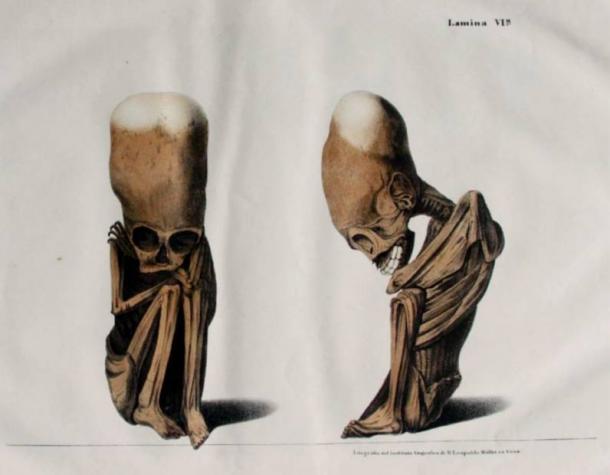
Lithograph by D. Leopoldo Mueller from the
Spanish 1851 Edition of Peruvian Antiquities
The same proof is to be found in another mummy which exists in the museum of Lima, under the direction of Don M. E. de Rivero.

Mark Laplume’s reconstruction of the Rivero and Tschudi’s foetus
Two elongated infant skulls, which Rivero and Tschudi mention in Peruvian Antiquities were discovered and brought to England by Captain Blankley and presented to the Museum of the Devon and Cornwall Natural History Society in 1838. Dr. Bellamy provided a detailed description of these skulls in 1842, suggesting that they belonged to two infants – male and female, few months and about a year old respectively. He indicated substantial structural differences from those of “normal” infant skulls and the absence of the signs of artificial pressure, as well as their similarity to other “Titicacan” skulls in the Museum of the College of Surgeons in London.
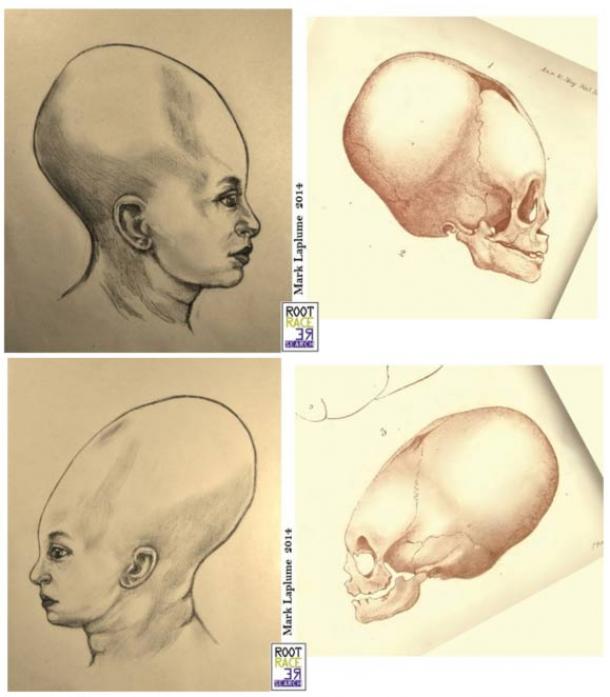
Lithographs of the skulls by J. Basire from
Bellamy's article (1842) and Mark Laplume's artistic reconstructions
The question now is how it happened that the cranial deformation paradigm became so prevalent? The answer to a large extent consists in the authority of Morton’s expert opinion and his extensive collection of skulls, which is now located in the University of Pennsylvania Museum of Archaeology and Anthropology. His influence was significant enough at the time to close the debate on elongated skulls for the next century and a half; until independent researchers, and I would like to mention Robert Connolly (who popularized elongated skulls in mid 1990s) and Brien Foerster, in particular, started to raise questions about the validity of the cranial deformation hypothesis by locating and showing elongated skulls to the public interested in finding out the true story of human origins.

Lithographs by John Collins, 1839 from Samuel
Morton's 'Crania Americana'
“I have been so fortunate as to have the examination, in my own and other collections, of nearly one hundred Peruvian crania: and the result is, that Peru appears to have been at different times peopled by two nations of differently formed crania, one of which is perhaps extinct, or at least exists only as blended by adventitious circumstances, in various remote and scattered tribes of the present Indian race. Of these t wo families, that which was antecedent to the appearance of the Incas is designated as the Ancient Peruvian, of which the remains have hitherto been found only in Peru, and especially in that division of it now called Bolivia.”
Although Ancient Peruvians had naturally elongated skulls, Morton concluded that they further tried to articulate this feature by head binding. This is an interesting observation in itself, since it raises a question why a race with naturally elongated skulls would aspire to further elongate them. Perhaps they were also preceded by a race whose skulls were even more elongated?
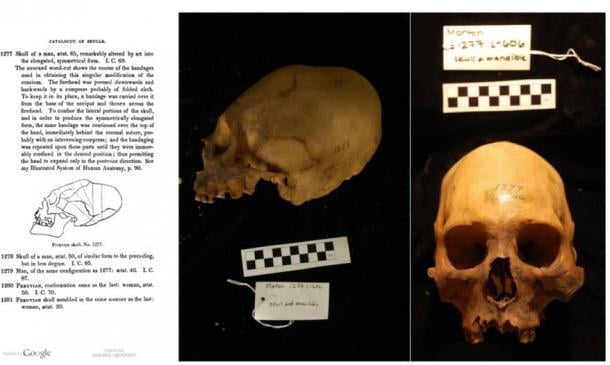
Morton Collection, Skull #1277, University of
Pennsylvania Museum of Archaeology and Anthropology, the Open Research Scan
Archive at Penn, and Janet Monge and P. Thomas Schoenemann; image in front from
Meigs, 1857
Accordingly, it is necessary to revisit Morton’s original encounter with elongated skulls. This is how he originally described cranial features of Ancient Peruvians:
“[The head] is small, greatly elongated, narrow its whole length, with a very retreating forehead, and possessing more symmetry than is usual in skulls of the American race. The face projec ts, the upper jaw is thrust forward , and the teeth are inclined outward . The orbits of the eyes are large and rounded, the nasal bones salient, the zygomatic arches expanded; and there is a remarkable simplicity in the sutures that connect the bones of the cranium.”
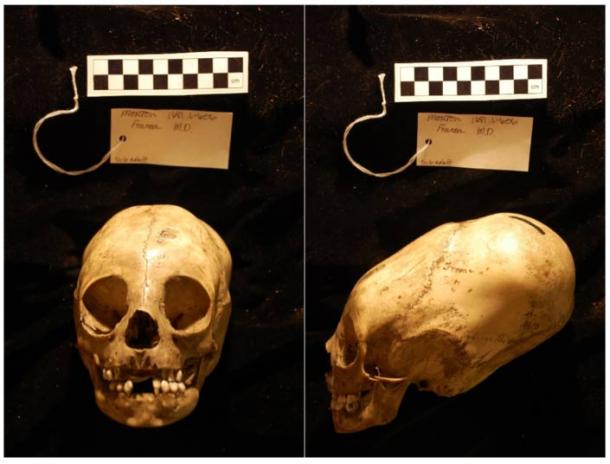
Morton Collection, Skull #1681, University of
Pennsylvania Museum of Archaeology and Anthropology, the Open Research Scan
Archive at Penn, and Janet Monge and P. Thomas Schoenemann
Featured image: Morton Collection, “Ancient Peruvian” skull #496, University of Pennsylvania Museum of Archaeology and Anthropology, the Open Research Scan Archive at Penn, and Janet Monge and P. Thomas Schoenemann
References:
Von Baer, Karl Ernst. Makrokephalen im Boden der Krim und Österreichs. St. Petersburg. 1860.
Bellamy, P. F. A brief Account of two Peruvian Mummies in the Museum of the Devon and Cornwall Natural History Society. in ‘Annals and Magazine of Natural History’. Vol. X. October 1842.
Graves, Robert J. Remarkable Skulls Found in Peru. No.15 of the Dublin Journal of Medical and Chemical Sciences. 1835.
Meigs, J. Aitken. Catalogue of Human Crania in the Collection of the Academie of Natural Sciences of Philadelphia: Based Upon the Third Edition of Dr. Morton's " Catalogue of Skulls". Philadelphia. 1857.
Morton, Samuel George. Crania Americana; or, A Comparative View of the Skulls of Various Aboriginal Nations of North and South America. To which is Prefixed an Essay on the Varieties of the Human Species. London. 1839.
Rivero, M.E., Tschudi, J.D. Antigüedades peruanas. Vienna, 1851 (Spanish). Rivero, M.E., von Tschudi, J.J. Peruvian antiquities. New York, 1853 (English).
From Ancient Origins
@ http://www.ancient-origins.net/unexplained-phenomena/elongated-skulls-utero-farewell-artificial-cranial-deformation-paradigm-002526?nopaging=1
For more information about elongated skulls see http://nexusilluminati.blogspot.com/search/label/elongated%20skulls
- Scroll down
through ‘Older Posts’ at the end of each section
Hope you like this
not for profit site -
It takes hours of work every day by
a genuinely incapacitated invalid to maintain, write, edit, research,
illustrate and publish this website from a tiny cabin in a remote forest
Like what you see? Please give anything
you can -
Contribute any amount and receive at
least one New Illuminati eBook!
(You can use a card
securely if you don’t use Paypal)
Please click below -
Spare Bitcoin
change?
For further enlightening
information enter a word or phrase into the random synchronistic search box @
the top left of http://nexusilluminati.blogspot.com
And see
New Illuminati – http://nexusilluminati.blogspot.com
New Illuminati on Facebook - https://www.facebook.com/the.new.illuminati
New Illuminati Youtube Channel - https://www.youtube.com/user/newilluminati/playlists
New Illuminati’s OWN Youtube Videos
-
New Illuminati on Google+ @ For
New Illuminati posts - https://plus.google.com/u/0/+RamAyana0/posts
New Illuminati on Twitter @ www.twitter.com/new_illuminati
New Illuminations –Art(icles) by
R. Ayana @ http://newilluminations.blogspot.com
The Her(m)etic Hermit - http://hermetic.blog.com
DISGRUNTLED SITE ADMINS PLEASE NOTE –
We provide
a live link to your original material on your site (and links via social
networking services) - which raises your ranking on search engines and helps
spread your info further!
This site
is published under Creative Commons (Attribution) CopyRIGHT (unless an
individual article or other item is declared otherwise by the copyright
holder). Reproduction for non-profit use is permitted & encouraged - if you
give attribution to the work & author and include all links in the original
(along with this or a similar notice).
Feel free
to make non-commercial hard (printed) or software copies or mirror sites - you
never know how long something will stay glued to the web – but remember
attribution!
If you
like what you see, please send a donation (no amount is too small or too large)
or leave a comment – and thanks for reading this far…
Live long
and prosper! Together we can create the best of all possible worlds…
From the New Illuminati – http://nexusilluminati.blogspot.com
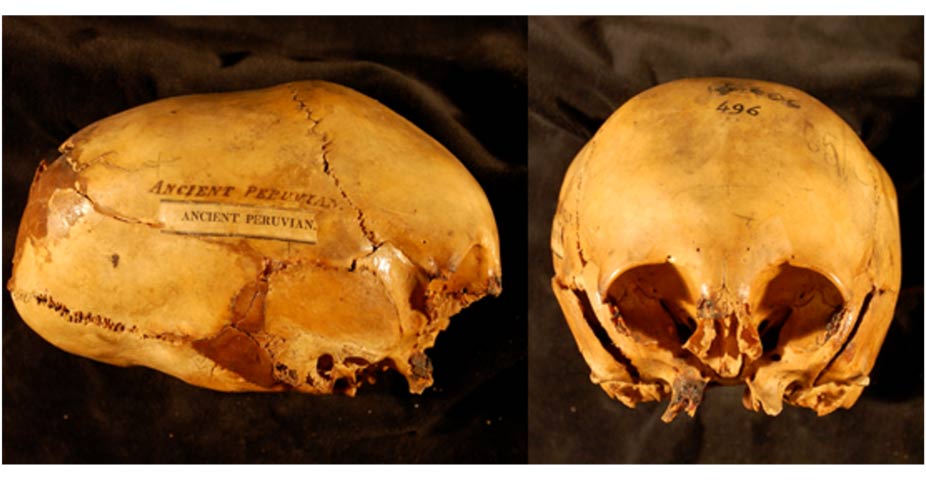
This revelation always causes me to wonder about the biological structure of the female or mother's reproductive system.
ReplyDeleteExcellent point - and it raises the question of maternal survival. However, the skull is so plastic at birth that we have seen a skull as elongated as these born in recent times - personally - and the natural elongated deformation rendered the birth viable without caesarian section.
DeleteThis is a case of 'not farewell' but a widening of the horizon of information. I personallyhave seen in the American Indians photos the Fact that they bound their babies heads with soft bark. Also in South America, Malaysis - photo in the Museum of Eternal Beauty, Malucaa and in parts of Africa. The question is 'why did these disparate ethnic groups do this? Who were they copying? Then you approximate the whole truth.
ReplyDelete